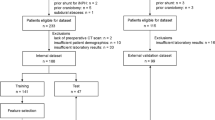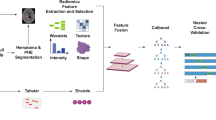Abstract
Artificial neural networks (ANN) have not been used in chronic subdural hematoma (CSDH) outcome prediction following surgery. We used two methods, namely logistic regression and ANN, to predict using eight variables CSDH outcome as assessed by the Glasgow outcome score (GOS) at discharge. We had 300 patients (213 men and 87 women) and potential predictors were age, sex, midline shift, intracranial air, hematoma density, hematoma thickness, brain atrophy, and Glasgow coma score (GCS). The dataset was randomly divided to three subsets: (1) training set (150 cases), (2) validation set (75 cases), and (3) test set (75 cases). The training and validation sets were combined for regression analysis. Patients aged 56.5 ± 18.1 years and 228 (76.0%) of them had a favorable outcome. The prevalence of brain atrophy, intracranial air, midline shift, low GCS, thick hematoma, and hyperdense hematoma was 142 (47.3%), 156 (52.0%), 177 (59.0%), 82 (27.3%), 135 (45.0%), and 52 (17.3%), respectively. The regression model did not show an acceptable performance on the test set (area under the curve (AUC) = 0.594; 95% CI, 0.435–0.754; p = 0.250). It had a sensitivity of 69% and a specificity of 46%, and correctly classified 50.7% of cases. A four-layer 8–3–4–1 feedforward backpropagation ANN was then developed and trained. The ANN showed a remarkably superior performance compared to the regression model (AUC = 0.767; 95% CI, 0.652–0.882; p = 0.001). It had a sensitivity of 88% and a specificity of 68%, and correctly classified 218 (72.7%) cases. Considering that GOS strongly correlates with the risk of recurrence, the ANN model can also be used to predict the recurrence of CSDH.


Similar content being viewed by others
References
Abouzari M, Rashidi A, Rezaii J, Esfandiari K, Asadollahi M, Aleali H, Abdollahzadeh M (2007) The role of postoperative patient posture in the recurrence of traumatic chronic subdural hematoma after burr-hole surgery. Neurosurgery 61:794–797
Adhiyaman V, Asghar M, Ganeshram KN, Bhowmick BK (2002) Chronic subdural haematoma in the elderly. Postgrad Med J 78:71–75
Amirjamshidi A, Abouzari M, Eftekhar B, Rashidi A, Rezaii J, Esfandiari K, Shirani A, Asadollahi M, Aleali H (2007) Outcomes and recurrence rates in chronic subdural haematoma. Br J Neurosurg 21:272–275
Amirjamshidi A, Abouzari M, Rashidi A (2007) Glasgow Coma Scale on admission is correlated with postoperative Glasgow Outcome Scale in chronic subdural hematoma. J Clin Neurosci 14:1240–1241
Amirjamshidi A, Eftekhar B, Abouzari M, Rashidi A (2007) The relationship between Glasgow coma/outcome scores and abnormal CT scan findings in chronic subdural hematoma. Clin Neurol Neurosurg 109:152–157
Asano Y, Hasuo M, Takahashi I, Shimosawa S (1992) Recurrent cases of chronic subdural hematoma—its clinical review and serial CT findings (in Japanese). No To Shinkei 44:827–831
Balestreri M, Czosnyka M, Chatfield DA, Steiner LA, Schmidt EA, Smielewski P, Matta B, Pickard JD (2004) Predictive value of Glasgow Coma Scale after brain trauma: change in trend over the past ten years. J Neurol Neurosurg Psychiatry 75:161–162
Cameron MM (1978) Chronic subdural haematoma: a review of 114 cases. J Neurol Neurosurg Psychiatry 41:834–839
Cucchiara BL, Kasner SE (2002) Atherosclerotic risk factors in patients with ischemic cerebrovascular disease. Curr Treat Options Neurol 4:445–453
DiRusso SM, Sullivan T, Holly C, Cuff SN, Savino J (2000) An artificial neural network as a model for prediction of survival in trauma patients: validation for a regional trauma area. J Trauma 49:212–220
Dreiseitl S, Ohno-Machado L (2002) Logistic regression and artificial neural networks classification models: a methodology review. J Biomed Inform 35:352–359
Eftekhar B, Mohammad K, Ardebili HE, Ghodsi M, Ketabchi E (2005) Comparison of artificial neural network and logistic regression models for prediction of mortality in head trauma based on initial clinical data. BMC Med Inform Decis Mak 5:3
El-Kadi H, Miele VJ, Kaufman HH (2000) Prognosis of chronic subdural hematomas. Neurosurg Clin N Am 11:553–567
Ernestus RI, Beldzinski P, Lanfermann H, Klug N (1997) Chronic subdural hematoma: surgical treatment and outcome in 104 patients. Surg Neurol 48:220–225
Fogelholm R, Waltimo O (1975) Epidemiology of chronic subdural haematoma. Acta Neurochir 32:247–250
Fukuhara T, Gotoh M, Asari S, Ohmoto T, Akioka T (1996) The relationship between brain surface elastance and brain reexpansion after evacuation of chronic subdural hematoma. Surg Neurol 45:570–574
Fuller JJ, Emmett M, Kessel JW, Price PD, Forsythe JH (2005) A comparison of neural networks for computing predicted probability of survival for trauma victims. W V Med J 101:120–125
Jennett B, Bond M (1975) Assessment of outcome after severe brain damage. Lancet 1:480–484
Jannett B, Teasdale G, Braakman R, Minderhoud J, Knill-Jones R (1976) Predicting outcome in individual patients after severe head injury. Lancet 1:1031–1034
Kapetanovic IM, Rosenfeld S, Izmirlian G (2004) Overview of commonly used bioinformatics methods and their applications. Ann N Y Acad Sci 1020:10–21
Kawakami Y, Chikama M, Tamiya T, Shimamura Y (1989) Coagulation and fibrinolysis in chronic subdural hematoma. Neurosurgery 25:25–29
Kotwica Z, Brzezinski J (1991) Chronic subdural haematoma treated by burr holes and closed system drainage: personal experience in 131 patients. Br J Neurosurg 5:461–465
Markwalder TM (1981) Chronic subdural hematomas: a review. J Neurosurg 54:637–645
Mock CN, Forjouh SN, Rivara FP (1999) Epidemiology of transport-related injuries in Ghana. Accid Anal Prev 31:359–370
Moini M, Rezaishiraz H, Zafarghandi MR (2000) Characteristics and outcome of injured patients treated in urban trauma centers in Iran. J Trauma 48:503–507
Mori K, Maeda M (2001) Surgical treatment of chronic subdural hematoma in 500 consecutive cases: clinical characteristics, surgical outcome, complications, and recurrence rate. Neurol Med Chir (Tokyo) 41:371–381
Nagata K, Basugi N, Fukushima T, Kurashina S, Tango T (1985) A quantitative study of brain atrophy on computed tomography—multivariate analysis for comparison between the linear measurement method and the pixel count method (in Japanese). No To Shinkei 37:255–262
Nagata K, Basugi N, Fukushima T, Tango T, Kaminuma T, Suzuki I, Kurashina S (1986) The normal range of cerebral atrophy during aging: statistical analysis of 500 normal subjects (in Japanese). No To Shinkei 38:1019–1025
Nagata K, Basugi N, Fukushima T, Tango T, Suzuki I, Kaminuma T, Kurashina S (1987) A quantitative study of physiological cerebral atrophy with aging. A statistical analysis of the normal range. Neuroradiology 29:327–332
Nakaguchi H, Tanishima T, Yoshimasu N (2001) Factors in the natural history of chronic subdural hematomas that influence their post-operative recurrence. J Neurosurg 95:256–262
Oishi M, Toyama M, Tamatani S, Kitazawa T, Saito M (2001) Clinical factors of recurrent chronic subdural hematoma. Neurol Med Chir (Tokyo) 41:382–386
Pang BC, Kuralmani V, Joshi R, Hongli Y, Lee KK, Ang BT, Li J, Leong TY, Ng I (2007) Hybrid outcome prediction model for severe traumatic brain injury. J Neurotrauma 24:136–146
Pearl A, Caspi R, Bar-Or D (2006) Artificial neural network versus subjective scoring in predicting mortality in trauma patients. Stud Health Technol Inform 124:1019–1024
Ramesh AN, Kambhampati C, Monson JR, Drew PJ (2004) Artificial intelligence in medicine. Ann R Coll Surg Engl 86:334–338
Roudsari BS, Sharzei K, Zargar M (2004) Sex and age distribution in transport-related injuries in Tehran. Accid Anal Prev 36:391–398
Schroeder LD, Sjoquist DL, Stephan PE (1986) Understanding regression analysis. Sage, Beverly Hills
Segal ME, Goodman PH, Goldstein R, Hauck W, Whyte J, Graham JW, Polansky M, Hammond FM (2006) The accuracy of artificial neural networks in predicting long-term outcome after traumatic brain injury. J Head Trauma Rehabil 21:298–314
Selker HP, Griffith JL, Patil S, Long WJ, D’Agostino RB (1995) A comparison of performance of mathematical predictive methods for medical diagnosis: identifying acute cardiac ischemia among emergency department patients. J Investig Med 43:468–476
Vavilala MS, Dunbar PJ, Rivara FP, Lam AM (2001) Coagulopathy predicts poor outcome following head injury in children less than 16 years of age. J Neurosurg Anesthesiol 13:13–18
Wakai S, Hashimoto K, Watanabe N, Inoh S, Ochiai C, Nagai M (1990) Efficacy of closed-system drainage in treating chronic subdural hematoma: a prospective comparative study. Neurosurgery 26:771–773
Yamamoto H, Hirashima Y, Hamada H, Hayashi N, Origasa H, Endo S (2003) Independent predictors of chronic subdural hematoma: results of multivariate analysis performed using a logistic regression model. J Neurosurg 98:1217–1221
Yeong EK, Hsiao TC, Chiang HK, Lin CW (2005) Prediction of burn healing time using artificial neural networks and reflectance spectrometer. Burns 31:415–420
Zargar M, Modaghegh MH, Rezaishiraz H (2001) Urban injuries in Tehran: demography of trauma patients and evaluation of trauma care. Injury 32:613–617
Zingale A, Chibbaro S, Florio A, Distefano G, Pocaro S (1999) Management of chronic subdural hematoma in patients treated with anticoagulation. J Neurosurg Sci 43:277–284
Author information
Authors and Affiliations
Corresponding author
Additional information
Comments
Jack Jallo, Philadelphia, USA
The application of an artificial neural network for outcome prediction of chronic subdural hemorrhage is indeed a novel idea and chronic subdural hemorrhage is one of the commonest types if intracranial injuries. As mentioned by the authors the incidence is expected to rise as the average population age rises, and yet it is one of the less frequently studied pathologies.
This study involves a large number of patients and looks at a large number of common variables for the input. Using a large input layer of eight variables and four-layer model rather than a three layer for the ANN probably contributes to the relatively high sensitivity and specificity of the study as well as the accuracy for prediction of outcome. Also classifying the outcome of patients into two categories, favorable or unfavorable, may provide less information regarding functional outcome, yet may help the ANN model in prediction of recurrence.
Applying the same model on a larger population with different demographics and co-morbidities will increase the validity of the model and possibly allow it to implement it on a larger scale in the future.
J. Humberto Tapia-Pérez, Magdeburg, Germany
Actually, the models on decision support, in medicine, is a very important issue. Many mathematical approaches are available; however, they are not widely understood and easily applicable. The recently increased use of artificial neural networks (ANN), one variant of nonlinear regression, has provided some evidence regarding superiority on decision (prognosis-therapy) support. In neurosurgery, trials or comparisons of these new models are scar yet. The variability and complicated number of interactions in neurosurgical/neurological diseases allow assuming that nonlinear relations are occurring. This problem could be at least theoretically resolved by using ANN.
Until today, there are no available studies on chronic subdural hematoma. This study provides us a direct comparison between two models with logistic and ANN, where a superiority of ANN has been demonstrated. Excluding previously identified factors for poor prognosis allow the developing of new models. The proposed factors for the ANN model facilitate prognostic accuracy in absence of co-morbidities. The calculated accuracy for the ANN model could be increased by introducing known factors.
The correlation between GCS and GOS should be token carefully, it exists the possibility of an internal mathematical structure on this. In other hand as argued by authors, the consideration of GCS more than severity but rather level consciousness is very reasonable. The tomographic factors would be expected, despite actual controversy. The interactions between these imagenologic variables could be adjusted by the internal networks on ANN.
It is needed that the proposed predictors be assessed on bigger populations with inclusion of all the co-morbidities. The more important message on this paper is the possibility to develop better models on decision support by using nonlinear statistics, large comparisons’ series are guaranteed.
Rights and permissions
About this article
Cite this article
Abouzari, M., Rashidi, A., Zandi-Toghani, M. et al. Chronic subdural hematoma outcome prediction using logistic regression and an artificial neural network. Neurosurg Rev 32, 479–484 (2009). https://doi.org/10.1007/s10143-009-0215-3
Received:
Revised:
Accepted:
Published:
Issue Date:
DOI: https://doi.org/10.1007/s10143-009-0215-3




